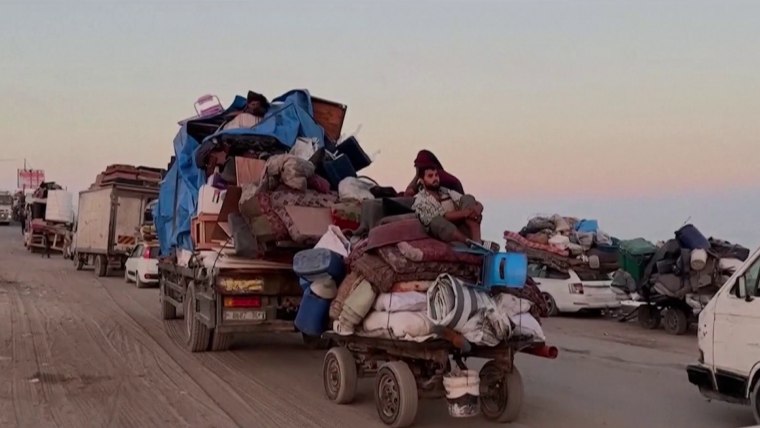This is an adapted excerpt from the Sept. 21 episode of “Velshi.”
In the Gaza Strip, one woman spent part of the past week stumbling toward uncertain safety with her husband, Ahmed Daif Allah, who had just lost his eyesight in an Israeli airstrike.
After leading her husband by the hand during a dayslong walk from Gaza City to the southern part of the enclave, Rafiq told a local journalist, “The journey is incredibly tough, more than anyone could imagine. … There is no pity, there is no humanity.”
They are among the hundreds of thousands of civilians who have fled Gaza City since Israel launched a new offensive last week. Israel dropped leaflets and posted on social media to warn civilians to move south. Israeli officials claim Gaza City contains about 3,000 Hamas fighters and is the group’s last major stronghold.
But the reason so many haven’t moved is that it remains unclear where they should go.
Earlier this month, Israel ordered the city’s full evacuation. Crowding, famine, expense and a treacherous journey ahead have made packing up and leaving a beyond-arduous task.
Before the war, it’s estimated that Gaza City had a population of about 700,000. Now, roughly 1 million Palestinians live in the area. While most of the city’s residents have not left, Gaza officials estimate 270,000 Palestinian men, women and children have fled since mid-August.
This is not the first time many Palestinians have been forced to evacuate since the start of the war. Just days after Oct. 7, 2023 — when Hamas attacked Israel, taking hundreds of hostages and killing about 1,200 people — Israel told the residents of Gaza City to move south. This began the process of uprooting nearly the entire population of the Gaza Strip.
Then, in 2024, after having moved hundreds of thousands of civilians south, Israel issued evacuation orders for the southern cities of Khan Younis and Rafah. So all of those people who were told to go south were now being told to head north. And here we are in September 2025, and the population is being forced to move once again.
But the reason so many haven’t moved is that it remains unclear where they should go. Much of the strip has either been declared a militarized zone or under one of the many standing evacuation orders.
Down in the south, Israel has designated the area of al-Mawasi as a “humanitarian zone” and urged Palestinians to head there. But hundreds of thousands are already crammed together seeking refuge there, struggling to obtain food and sleeping on the streets.
And even there they are not completely safe from airstrikes. A UNICEF spokesperson told the BBC that when evacuating to al-Mawasi, “families are fleeing one hellscape only to end up in another.”
Hamas still holds 48 hostages, 20 of whom are believed to be alive, out of the 250 it seized during the Oct. 7 attacks. But while many families of those hostages have urged de-escalation to get a ceasefire and to resume the hostage-for-prisoner exchanges that worked well, Israel has forged ahead with its military campaign despite growing domestic and international outcry.
So the war drags on. More than 65,200 people have been killed in Gaza since the start of the war, according to the Palestinian Health Ministry, and half are women and children. According to the International Rescue Committee, 1.9 million Palestinians — 90% of the population — have been internally displaced.

